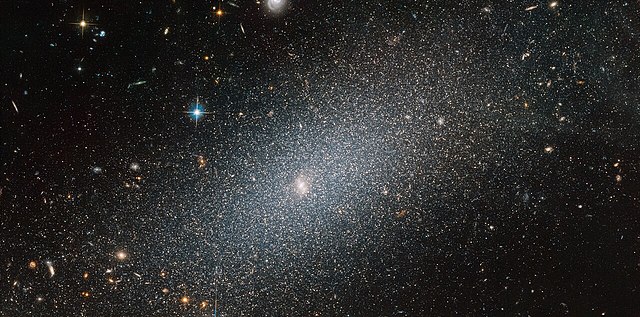Dwarf galaxies are small, relatively dim, and less massive galaxies compared to their larger counterparts, such as spiral and elliptical galaxies. Despite their modest size, dwarf galaxies play a crucial role in our understanding of the universe’s structure, evolution, and the nature of dark matter. Here’s a comprehensive guide to these compact cosmic marvels:
1. Classification of Dwarf Galaxies:
- Dwarf Elliptical Galaxies (dEs): These are the most common type of dwarf galaxies. They have an elliptical shape and contain mainly old stars. They are often found in galaxy clusters.
- Dwarf Spheroidal Galaxies (dSphs): These are small and faint galaxies with a spheroidal shape. They also tend to be old and are typically located near larger galaxies like the Milky Way and Andromeda.
- Dwarf Irregular Galaxies (dIrrs): These galaxies lack a clear structure and can contain both young and old stars. They often exhibit active star-forming regions.

2. Stellar Populations:
- Dwarf galaxies can host a range of stellar populations, from old and red stars to young and blue ones. The balance between these populations provides clues about their evolutionary history.
3. Dark Matter:
- Dwarf galaxies are important in the study of dark matter. Their relatively low luminosity suggests they contain significant amounts of unseen dark matter, as their visible matter alone cannot account for their gravitational dynamics.
4. Galactic Cannibalism:
- Dwarf galaxies are sometimes disrupted and absorbed by larger galaxies in a process known as galactic cannibalism. This phenomenon can lead to the growth of larger galaxies and the creation of tidal tails and streams.
5. Satellite Galaxies:
- Many dwarf galaxies are satellite galaxies of larger galaxies like the Milky Way and Andromeda. These satellite dwarf galaxies are important for testing cosmological models and understanding the dynamics of galaxy groups.
6. Star Formation:
- Some dwarf galaxies are actively forming stars, while others have ceased their star-forming activity. The study of star formation in dwarfs provides insights into the conditions necessary for stellar birth.
7. Environmental Influence:
- The environment in which dwarf galaxies reside can significantly impact their evolution. Galactic interactions, gravitational forces, and radiation from nearby galaxies can all influence their structure and star formation.
8. Cosmic Archaeology:
- Because dwarf galaxies are composed of older stars and have experienced fewer interactions, they can be considered as cosmic fossils. Studying their properties can help astronomers understand conditions in the early universe.
9. Irregular Morphology:
- Dwarf irregular galaxies often have an irregular and asymmetrical appearance, with no distinct spiral arms or central bulge. These features are often indicative of their dynamic and unstructured nature.
10. Ongoing Research:
Dwarf galaxies continue to be a subject of active research in astrophysics, cosmology, and galaxy formation. Observations, simulations, and theoretical models are continually refined to gain a better understanding of these cosmic marvels.
Dwarf galaxies may be small in size, but they are invaluable in helping us unravel some of the universe’s greatest mysteries, from the nature of dark matter to the evolution of galaxies in the vast cosmic web. Their study enriches our understanding of the cosmos and the intricate processes that shape it.











